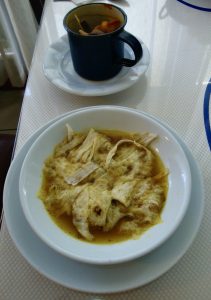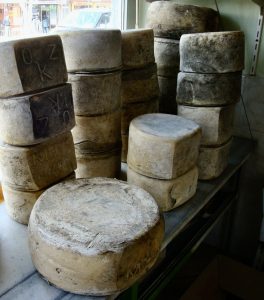“Kaz var (We have goose),”‘ say the signs in restaurant windows which is enough to make anyone except a vegetarian start licking their lips. Unfortunately , they turn out to be something of a come-on since any actual request to be served said goose results only in mournful looks all round and much muttering about expense and the need to order in advance, never a good sign when you’re a tourist on a tight schedule.
But in 2010 a restaurant whose sole raison d’etre was the serving of goose finally opened its doors on Sehir Polis Nuri Yıldız Sokak in downtown Kars. Nuran Özyılmaz and her daughters spotted a gap in the market for those who’d had their fill of kebabs. Soon they were roasting the birds in the Kars Kazevi on a seven-day basis, dishing up big helpings of goose on a bed of bulgur pilavı and turşu (pickles) with ayran to wash it all down. The birds were reared on local farms then slaughtered at about eight months and prepared for cooking by village women. “We eat everything,” said Nuran Hanım who learnt how to cook the birds from her mother. “But we only serve the main part of the body here – the village women keep the heads and feet.”
Older people claimed to remember the days when geese were smoked on local chimneypots while also reminiscing about how they used to be cooked in traditional tandır (pit) ovens. Now all such time-consuming quirkiness had been consigned to history and even in the Kazevi the geese were roasted in a kitchen to do Arçelik proud. “It’s completely organic,” Nuran Hanım reminded me although no one in town had seen fit to jump on the goose-fat bandwagon yet.
 But goose was not the only culinary surprise to be had in Kars. The piti sold at Cafe Kristal on Halitpaşa Caddesi turned out to be a curious cross between soup and stew. Served in a blue enamel mug, piti metamorphosed into an unexpectedly filling two-course meal with a complicated serving procedure. First, some of the meat stock was poured out into a bowl and sprinkled with strips of lavaş (pitta) bread. Then the remaining contents of the mug were emptied into a second bowl and, hey presto, you had a wonderful chickpea and lamb main course as well.
But goose was not the only culinary surprise to be had in Kars. The piti sold at Cafe Kristal on Halitpaşa Caddesi turned out to be a curious cross between soup and stew. Served in a blue enamel mug, piti metamorphosed into an unexpectedly filling two-course meal with a complicated serving procedure. First, some of the meat stock was poured out into a bowl and sprinkled with strips of lavaş (pitta) bread. Then the remaining contents of the mug were emptied into a second bowl and, hey presto, you had a wonderful chickpea and lamb main course as well.
Anyone who had ever visited Iran would have recognised piti as a cousin of abgusht, the much-loved staple meal of teahouses countrywide. In Iran the chickpeas and meat are pounded down into a paste which means that you can’t fish out the chunks of lamb fat that come with them. Either way, it was a delicious and surprisingly cheap treat, unlike the pricy goose.
A few bakers in the Kars back streets also sold kete, roundels of a thick bread with a texture closer to cake, which made the perfect accompaniment for the holey gravyer cheese on sale along Halitpaşa Caddesi in shops that also stocked excellent local kaşar peyniri, a strong Cheddar-like cheese; tulum peyniri, which is matured inside a goatskin; and bal (honey) straight from the comb. Like goose, Kars gravyeri came with a hefty price tag. On the other hand it also came with an interesting history too. From 1878 to 1920 Kars was occupied by the Russians and many of the surrounding villages acquired populations of Westerners, including a group of Swiss cheese-makers who adapted the recipe for Emmental to create Kars gravyeri.
Today there are two cheese museums in the area, one in Kars itself, the other in the village of Boğatepe.
